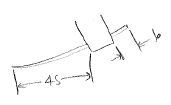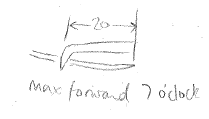There are some pictures here - took a picture of the handle positions at 12, 3, 6 and 9 o'clock. Not the easiest thing to photograph on a grey, wet day! Also made a short video
These instructions are based on a manual linker, I do not have any information about electric linkers. I did some sketches of my linker as it's rather hard to photograph.

1. The needle should be set so that 6mm protrudes from the back, and approx. 45mm protrudes from the front. The needle should curve down and to the left/right. If it were possible to view the needle from directly above, it would appear to be straight. If it is not straight it will not work properly.
2. The needle goes in and out directly above the groove in the linker point. There is a small gap of about 0.5mm to 1mm here.
3. The looper should be set so that it is almost horizontal. Mine appears to be perhaps 1 degree higher at the working end. The point of the looper is to the top. The looper arm is about 12mm out of its socket. 

4. When the needle is fully extended (handle approx. 7 o'clock), the overlap between looper and needle is approx. 20mm. The vertical gap at this point is approx. 1mm
Advice for setting up - set the needle as in (1), then adjust the looper, there is lots more room to adjust the looper.
Continuing slowly onwards with Blusa and Kimi. Trying out a Clover soft-touch hook - not sure how I feel yet!

21 comments:
Hi Jane
Thank you so much for taking the time to make the video and drawings of your hague linker for me. I really have appreciated this very much.
I have noticed that your needle is much larger than mine. When I look how far your needle goes past the looper, mine is certainly nothing like this.
I contacted Hague today regarding the needles that I purchased. They say that this is definately the type for my machine but they are the newer type needles they now manufacture which are shorter in size. So they have offered to refund my money, but this isn't much help when you have a linker but no needles to fit it.
The only thing I can do now is to purchase a couple of hand linker needles and see if they might work.
I suppose its worth a try.
I will certainly keep in touch. So thanks once again.
Hi there, this has been really helpful, thanks :) I wonder if you've had any experience with the handle spinning in the cog and not turning the machine? And if you have any advice for me? It generally works fine when there's no pressure (so no garment and needle not threaded) I've taken it apart, oiled it and cleaned it, handle still slipping. Any words of wisdom would be greatly appreciated :)
Sorry, that's never happened to me! Perhaps you should give Hague a call.
Wow thank you for this page. Without this I would be a very unhappy bunny as I purchased a linker in fully working order that wasn't but by following your measurements and diagrams it is not working perfectly. A FIRST CLASS STAR SITE. thank you thank you.
hi this is my first ever hague linker but it didn't come with a manual so my question is [probably very silly] when you start and end do you have aq few chains before the actual garment and if so what do you do with the chains after do you hand sew them out of the way. thank you
I tend to start and end with a few chains. You can sew them into the seam with a large eyed needle.
Thanks for posting this, we have acquired an old D10 which I stripped down to clean and remove all the rust. Of course it wasn't working properly when I reassembled until I found your blog, now it is linking very successfully.
Thanks again.
Glad I could help!
I have recently bought a second hand linker and it does not link all stitches. It is a manual blue linker, probably quite old but otherwise in good condition.
The loop on the bar drops off and so there are no links, it comes back intermittently. Hope this makes sense. Can you help please.
I'm wondering what Bob used to clean his linker. Any ideas?
Thanks!
Lynda
No - but you can use strong tea to clean rust from machine needles. Leave them soaking overnight. You can also sometimes use WD40 to clean stuff - not as a lubricant though, it goes gunky with time.
Hi I have lost my manual. Not used the linker for a while. Does it need oiling anywhere?
I'd go get the manual from machineknittingetc and see if it says. If it doesn't say, take a look at the mechanism. Anywhere that there's sliding surfaces or pivots may need a little oil.
Hello,
I'm just about to buy a Hague linker for my standard gauge knitting machine (mattress stitching is strangely one of my favourite things but not on smelly, oiled 3-ply). Having had some disappointing second-hand buys of knitting machine things in the past, I'm going crazy and buying a new linker. I wonder if you've any advice on whether it's worth getting an electric one, rather than a hand-driven one? I like the idea of hand-driven on principle but I don't know how important it is to have that extra hand free.
Sorry to be cheeky asking this- it can be hard to find specific advice in lonely, echoing world of machine knitting (especially compared to the fluffy, crowded world of hand knitting)- I'd be very grateful for any advice you have.
I found the manual linker to be more than adequate - I think I'd only have considered upgrading to an electric one if I was going into production, because I'd imagine it is faster.
Thank you very much for your speedy reply RE hand versus electric linkers
Hi. Have you any idea where I could get a spare needle for my 30+ year old linker, it's the grey one I think the needle is 160/23.
My only suggestion is that you contact the manufacturer. Sorry, I don't manufacture these devices myself!
Hi. I have a linker and I just can't seem to get the needle and linker right and advise?
No further advice I'm afraid, just keep tweaking the needle and eventually it will be sweet. I'd do the length first and then adjust the angle.
Fab thank you. Best instructions I've seen, more help than Hague. I've finally got my linker sorted to the point that it now can link of live stiches.
Post a Comment